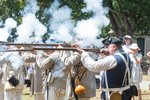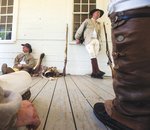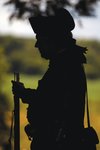



SANFORD — Muskets from Loyalist militiamen fired upon the Alston house as women and children hid in the chimney sill. Meanwhile, David Fanning and his troops inched closer and closer threatening to set the house alight.
“Come out, Alston!” Fanning yelled as balls from his men’s muskets pockmarked the outer walls of the Patriot Phillip Alston’s family home. “Your time is through.”
After nearly three hours of battle and several casualties on both sides, Alston’s wife, Temperance, emerges from the house holding their baby daughter urging a ceasefire and peace agreement. Fanning agrees, and the Alston house is surrendered to the Loyalist militia.
The skirmish — known as the Battle of the House in the Horseshoe — took place on July 29, 1781, during the American Revolution. Now, 241 years later, the remnants of that night still remain. Visitors to the house near the Deep River can still see the bullet holes in the back walls where Fanning’s men shot into the house, the crimson paint of the interior walls and the ash-covered chimney sill where the Alston children hid with their mother during the fighting.
The Alston House Association and North Carolina Historic Sites hosted a reenactment of the battle on Saturday, its first since COVID-19 began. The event was filled with dozens of reenactors and more than 200 people of people from across the region. The event included tours of the house, a musket firing demonstration and presentations about everyday trades of the time period.
One of the trades on display was weaving. Mary Beth Voelker sat at her handmade loom modeled after a traditional revolutionary design showing participants how women of the time made shirts, ribbons and dresses from wool.
“My husband made this replica tape-loom,” she said. “I’m fascinated by the way people lived and the textiles they chose to wear in these periods.”
Voelker has been participating in historical reenactments since she was a teenager, and volunteered at the Alston House for five years. She even handmade the baggy maroon dress and white cloak she wears for the event. She said she believes living history is the best way for people to understand how people actually lived.
“People don’t realize that it used to take a year to make a mens shirt,” Voelker said. “It’s a great event because everybody gets to play dress-up, let’s pretend, but also learn these lost skills.”
Next to the weaver stood the tailor, Drew Neill, a historian at the Alamance Battleground Historic Site. He said he believes this work is valuable because it shows people that there is more to the past than just conflict.
“We tend to think of history in terms of battles,” Neill said. “But most of history isn’t conflict, it’s just normal guys trying to make a living. That’s why it’s great to show the ins and outs of trade, not just the battle.”
The story of the Alston House and family is also imperfect. Part of Saturday’s event was sharing the darker past of the family, including the lives of those it enslaved. Records show Alston held nine enslaved people whose identities still remain unknown.
“We keep trying to uncover the names and the stories of all the people that passed through here,” said Marisa Balatico, education coordinator for N.C. Historic Sites. “These stories haven’t been told for so many years.”
Balatico said until recently, Alston was regarded as a war hero and a patriot, but that misses part of his complicated legacy.
For starters, the Battle of the House in the Horseshoe didn’t actually advance the cause of the American Revolution. In fact, the skirmish began after a purely emotional dispute.
“Once you really dig into the layers and discover all the things Alston was involved in after the Revolutionary War, you see there are few people who actually have good things to say about him,” Balatico said.
N.C. Historic Sites decided to dig into the layered complexities of Alston during the pandemic and Balatico said it is a big part of the organization’s future research initiatives for the house.
“We’re really excited to expand these diverse voices and spread that story together,” she said.
Despite its darker sides, many reenactors still believe it is important to preserve the Alston House. Robert Lee Garner, an N.C. Historic Sites maintenance worker, dresses in a big straw hat, beige vest and walks around barefooted as he invites guests to tour the house.
“Preserving these buildings shows us who we were and where we came from,” Garner said. “It gives us an understanding of why and how things were done.”
Garner said he believes the past shows us why we are the way we are today, which is one of the reasons it was so exciting for this event to be the first one to take place since the pandemic began.
“It really gives you your purpose back,” he said. “During COVID, a lot of people lost enthusiasm to tell stories, but bringing people back gives you somebody to share that story with. The hope is, they’ll walk away with something that they’ll share with somebody else.”
Long-time reenactors will tell you, the story they share is one of an incomplete America. A tale of a young country finding its way and grappling with big issues like culture and what rights people should have — issues that, according to reenactor Tyler Mink, we’re still grappling with today.
“Culture and rights are always in progress, and America always needs to strive to move forward,” Mink said. “The American Revolution attempted to answer questions about what it wanted to become, but a lot of things still remain unresolved.”
Mink portrayed the role of David Fanning in the reenactment. He said he believes the conflict between Fanning and Alston was a microcosm of the egotistical battles America would grapple with for centuries to come.
“The study of the American Revolution is always the study of rights and how a group of people saw a way that could be better,” he said. “Yet, because of our own shortcomings we fell short of our potential.”
Mink said studying that process — trying to answer questions about the future of the nation and coming up short — shows us the conversations we should be having today.
“Demonstrations like these are meant to cast a human light on these people,” he said. “We tend to put the people of the past on pedestals and deify them. These reenactments remind people that the Revolution was a very real, very turbulent time, which I think is something people today can appreciate.”
The normal operating hours for the Alston House are Tuesday through Saturday 9 a.m. to 5 p.m. the house is closed Sunday, Monday and most major holidays. For more information about the Alston House visit www.historicsites.nc.gov/all-sites/house-horseshoe, call 910-947-2051 or email horseshoe@ncdcr.gov.
Reporter Ben Rappaport can be reached at brappaport@chathamnr.com or on Twitter @b_rappaport.